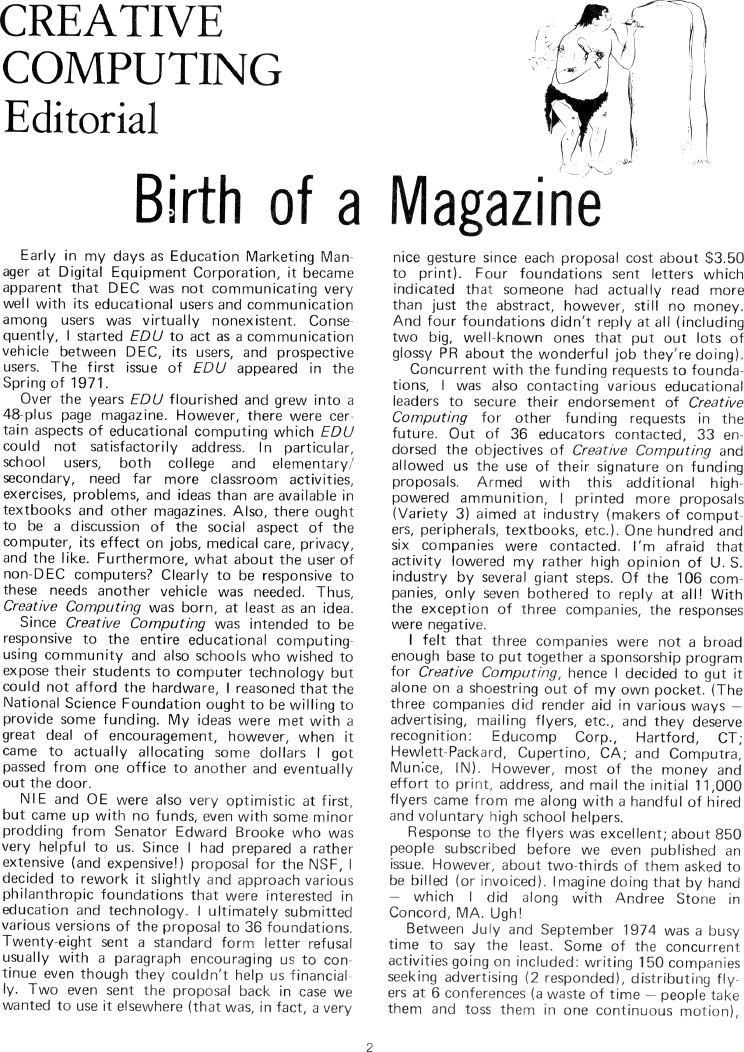The Best of Creative Computing Volume 1 (published 1976)
Birth of a Magazine (History of Creative Computing)

CREATIVE COMPUTING
Editorial
Birth of a Magazine
Early in my days as Education Marketing Manager at Digital Equipment
Corporation, it became
apparent that DEC was not communicating very
well with its educational users and communication
among users was virtually nonexistent. Consequently, I started EDU to act as a
communication
vehicle between DEC, its users, and prospective
users. The first issue of EDU appeared in the
Spring of 1971.
Over the years EDU flourished and grew into a
48-plus page magazine. However, there were certain aspects of educational
computing which EDU
could not satisfactorily address. In particular,
school users, both college and elementary/
secondary, need far more classroom activities,
exercises, problems, and ideas than are available in
textbooks and other magazines. Also, there ought
to be a discussion of the social aspect of the
computer, its effect on jobs, medical care, privacy,
and the like. Furthermore, what about the user of
non-DEC computers? Clearly to be responsive to
these needs another vehicle was needed. Thus,
Creative Computing was born, at least as an idea.
Since Creative Computing was intended to be
responsive to the entire educational computing using community and also schools
who wished to
expose their students to computer technology but
could not afford the hardware, I reasoned that the
National Science Foundation ought to be willing to
provide some funding. My ideas were met with a
great deal of encouragement, however, when it
came to actually allocating some dollars I got
passed from one office to another and eventually
out the door.
NIE and OE were also very optimistic at first,
but came up with no funds, even with some minor
prodding from Senator Edward Brooke who was
very helpful to us. Since I had prepared a rather
extensive (and expensive!) proposal for the NSF, I
decided to rework it slightly and approach various
philanthropic foundations that were interested in
education and technology. I ultimately submitted
various version of the proposal to 36 foundations.
Twenty-eight sent a standard form letter refusal
usually with a paragraph encouraging us to continue even though they couldn't
help us financially. Two even sent the proposal back in case we
wanted to use it elsewhere (that was, in fact, a very
nice gesture since each proposal cost about $3.50
to print). Four foundations sent letters which
indicated that someone had actually read more
than just the abstract, however, still no money.
And four foundations didn't reply at all (including
two big, well-known ones that put out lots of
glossy PR about the wonderful job they're doing).
Concurrent with the funding requests to foundations, l was also contacting
various educational
leaders to secure their endorsement of Creative
Computing for other funding requests in the
future. Out of 36 educators contacted, 33 endorsed the objectives of Creative
Computing and
allowed us the use of their signature on funding
proposals. Armed with this additional high-powered ammunition, I printed more
proposals
(Variety 3) aimed at industry (makers of computers, peripherals, textbooks,
etc.). One hundred and
six companies were contacted. I'm afraid that
activity lowered my rather high opinion of U.S.
industry by several giant steps. Of the 106 companies, only seven bothered to
reply at all! With
the exception of three companies, the responses
were negative.
I felt that three companies were not a broad
enough base to put together a sponsorship program
for Creative Computing, hence I decided to gut it
alone on a shoestring out of my own pocket. (The
three companies did render aid in various ways -
advertising, mailing flyers, etc., and they deserve
recognition: Educomp Corp., Hartford, CT;
Hewlett-Packard, Cupertino, CA; and Computra,
Munice, IN). However, most of the money and
effort to print, address, and mail the initial 11,000
flyers came from me along with a handful of hired
and voluntary high school helpers.
Response to the flyers was excellent; about 850
people subscribed before we even published an
issue. However, about two-thirds of them asked to
be billed (or invoiced). Imagine doing that by hand
- which I did along with Andree Stone in
Concord, MA. Ugh!
Between July and September 1974 was a busy
time to say the least. Some of the concurrent
activities going on included: writing 150 companies
seeking advertising (2 responded), distributing flyers at 6 conferences (a waste
of time - people take
them and toss them in one continuous motion),


